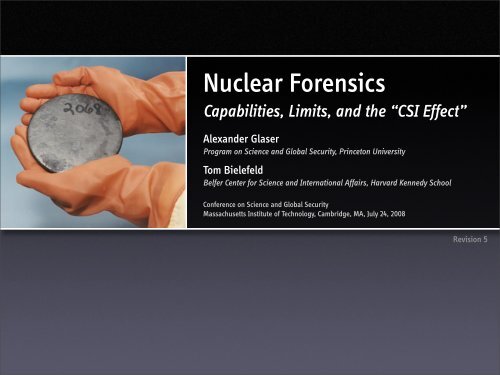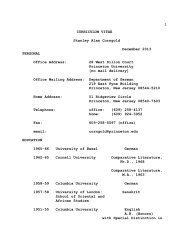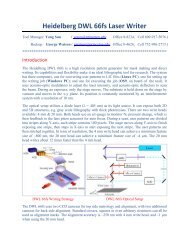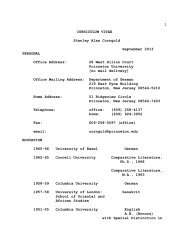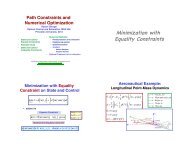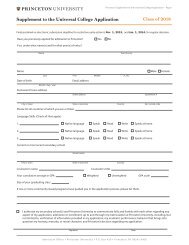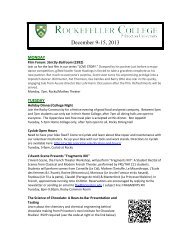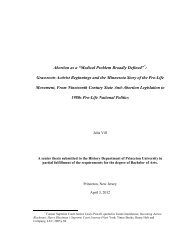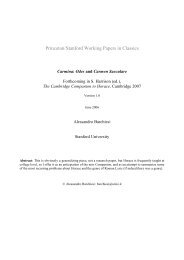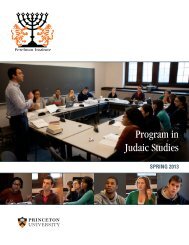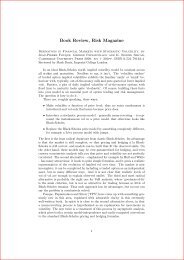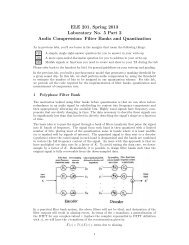Nuclear Forensics: Capabilities, Limits, and the - Princeton University
Nuclear Forensics: Capabilities, Limits, and the - Princeton University
Nuclear Forensics: Capabilities, Limits, and the - Princeton University
You also want an ePaper? Increase the reach of your titles
YUMPU automatically turns print PDFs into web optimized ePapers that Google loves.
<strong>Nuclear</strong> <strong>Forensics</strong><br />
<strong>Capabilities</strong>, <strong>Limits</strong>, <strong>and</strong> <strong>the</strong> “CSI Effect”<br />
Alex<strong>and</strong>er Glaser<br />
Program on Science <strong>and</strong> Global Security, <strong>Princeton</strong> <strong>University</strong><br />
Tom Bielefeld<br />
Belfer Center for Science <strong>and</strong> International Affairs, Harvard Kennedy School<br />
Conference on Science <strong>and</strong> Global Security<br />
Massachusetts Institute of Technology, Cambridge, MA, July 24, 2008<br />
Revision 5
A. Glaser <strong>and</strong> T. Bielefeld, <strong>Nuclear</strong> <strong>Forensics</strong>: <strong>Capabilities</strong>, <strong>Limits</strong>, <strong>and</strong> <strong>the</strong> “CSI Effect,” Science <strong>and</strong> Global Security Conference, July 24, 2008, Cambridge, MA<br />
Overview<br />
What is <strong>Nuclear</strong> <strong>Forensics</strong>?<br />
The Technical Basis of <strong>Nuclear</strong> <strong>Forensics</strong><br />
(2 examples)<br />
What Can (or Should) Be <strong>the</strong> Role of <strong>Nuclear</strong> <strong>Forensics</strong> Today?
A. Glaser <strong>and</strong> T. Bielefeld, <strong>Nuclear</strong> <strong>Forensics</strong>: <strong>Capabilities</strong>, <strong>Limits</strong>, <strong>and</strong> <strong>the</strong> “CSI Effect,” Science <strong>and</strong> Global Security Conference, July 24, 2008, Cambridge, MA<br />
Detection of “Joe-1” in August 1949<br />
Source: U.S. Wea<strong>the</strong>r Bureau Report on Alert Number 112 of <strong>the</strong> Atomic Detection System, 29 September 1949, PSF: Subject File 1940-1953, National Security<br />
Council – Atomic Files, Box 173, Folder: “Atomic Bomb: Reports,” Harry S. Truman Presidential Library; Courtesy: Michael D. Gordin, <strong>Princeton</strong> <strong>University</strong>
A. Glaser <strong>and</strong> T. Bielefeld, <strong>Nuclear</strong> <strong>Forensics</strong>: <strong>Capabilities</strong>, <strong>Limits</strong>, <strong>and</strong> <strong>the</strong> “CSI Effect,” Science <strong>and</strong> Global Security Conference, July 24, 2008, Cambridge, MA<br />
What is <strong>Nuclear</strong> <strong>Forensics</strong>?<br />
<strong>Nuclear</strong> forensic analysis seeks to determine<br />
<strong>the</strong> physical, chemical, elemental, <strong>and</strong> isotopic characteristics<br />
of nuclear [or radiological] material of unknown origin<br />
Based on this analysis, some (first-principle) conclusions can be drawn, e.g.:<br />
• Age of <strong>the</strong> material (time elapsed since production or last purification)<br />
• General statements about <strong>the</strong> production process<br />
If intercepted or recovered material is registered in a database,<br />
<strong>the</strong>n it can be “matched” with high confidence<br />
O<strong>the</strong>r a priori knowledge might be helpful, too<br />
Database may or may not contain a physical sample of <strong>the</strong> same material
A. Glaser <strong>and</strong> T. Bielefeld, <strong>Nuclear</strong> <strong>Forensics</strong>: <strong>Capabilities</strong>, <strong>Limits</strong>, <strong>and</strong> <strong>the</strong> “CSI Effect,” Science <strong>and</strong> Global Security Conference, July 24, 2008, Cambridge, MA<br />
What is <strong>Nuclear</strong> <strong>Forensics</strong>?<br />
Pre-explosion vs Post-explosion <strong>Forensics</strong><br />
Analysis of <strong>the</strong> post-explosion debris is used to determine pre-explosion isotopics<br />
Type <strong>and</strong> “sophistication” of weapon design<br />
Most important (technical) difference: fewer signatures for post-explosion analysis<br />
No residual information on physical characteristics (e.g. morphology)<br />
Less/no information on trace elements<br />
<strong>Nuclear</strong> <strong>Forensics</strong> vs Attribution<br />
An attribution process, in which <strong>the</strong> origin or route of intercepted<br />
nuclear material is identified, combines <strong>the</strong> nuclear forensic analysis with<br />
law enforcement <strong>and</strong> intelligence data
A. Glaser <strong>and</strong> T. Bielefeld, <strong>Nuclear</strong> <strong>Forensics</strong>: <strong>Capabilities</strong>, <strong>Limits</strong>, <strong>and</strong> <strong>the</strong> “CSI Effect,” Science <strong>and</strong> Global Security Conference, July 24, 2008, Cambridge, MA<br />
1994 Munich Plutonium<br />
PuO2 platelet<br />
Hexagonal U3O8<br />
Intercepted at Munich Airport in August 1994 on a Lufthansa flight from Moscow<br />
PuO2 rod<br />
• 363 grams of plutonium (87% Pu-239) <strong>and</strong> 122 grams of uranium (560 grams of plutonium <strong>and</strong> uranium oxide)<br />
• In addition: 210 grams of enriched lithium metal (89.4% Li-6)<br />
“ Most likely, <strong>the</strong> plutonium was a mixture of different spent fuels (e.g., a low-burn-up or weapons-grade plutonium<br />
<strong>and</strong> a high-burn-up fuel) <strong>and</strong> had no direct connection with <strong>the</strong> uranium present.”<br />
K.-R. Lützenkirchen, CSI: Karlsruhe, Actinide Research Quarterly, 2007<br />
Source: ITU
“<br />
“<br />
A. Glaser <strong>and</strong> T. Bielefeld, <strong>Nuclear</strong> <strong>Forensics</strong>: <strong>Capabilities</strong>, <strong>Limits</strong>, <strong>and</strong> <strong>the</strong> “CSI Effect,” Science <strong>and</strong> Global Security Conference, July 24, 2008, Cambridge, MA<br />
1999 Bulgarian HEU<br />
Intercepted at Turkish-Bulgarian border<br />
in May 1999<br />
• 10 grams of HEU (72% U-235)<br />
• High U-236 content (13%)<br />
Findings of 9-month forensic analysis:<br />
• Reprocessed uranium from high-burnup fuel<br />
• Original U-235 content: 90%<br />
[This investigation] was <strong>the</strong> most thorough <strong>and</strong> far-reaching analysis of illicit nuclear material<br />
ever conducted.”<br />
The attribution of <strong>the</strong> Bulgarian HEU [...] remains incomplete. Despite <strong>the</strong> comprehensive<br />
forensic investigation <strong>and</strong> wealth of data, nei<strong>the</strong>r <strong>the</strong> original source of <strong>the</strong> HEU nor <strong>the</strong> point at<br />
which legitimate control was lost has yet been unambiguously identified.”<br />
Moody, Hutcheon, <strong>and</strong> Grant, 2005, p. 402 <strong>and</strong> p. 418
180<br />
160<br />
140<br />
120<br />
100<br />
80<br />
60<br />
40<br />
20<br />
0<br />
A. Glaser <strong>and</strong> T. Bielefeld, <strong>Nuclear</strong> <strong>Forensics</strong>: <strong>Capabilities</strong>, <strong>Limits</strong>, <strong>and</strong> <strong>the</strong> “CSI Effect,” Science <strong>and</strong> Global Security Conference, July 24, 2008, Cambridge, MA<br />
Confirmed Incidents<br />
(1993-2006)<br />
Source:<br />
Combating Illicit Trafficking in <strong>Nuclear</strong> <strong>and</strong> o<strong>the</strong>r Radioactive Material,<br />
Technical Guidance Reference Manual, IAEA <strong>Nuclear</strong> Security Series No. 6,<br />
International Atomic Energy Agency, Vienna, 2007<br />
1993 1994 1995 1996 1997 1998 1999 2000 2001 2002 2003 2004 2005 2006<br />
<strong>Nuclear</strong> Material O<strong>the</strong>r Radioactive Material<br />
Both <strong>Nuclear</strong> <strong>and</strong> O<strong>the</strong>r Radioactive Material Radioactively Contaminated Material<br />
O<strong>the</strong>r
Technical Basis of <strong>Nuclear</strong> <strong>Forensics</strong>, Part I<br />
Pre- vs Post-Explosion Isotopics<br />
(highly simplified)
A. Glaser <strong>and</strong> T. Bielefeld, <strong>Nuclear</strong> <strong>Forensics</strong>: <strong>Capabilities</strong>, <strong>Limits</strong>, <strong>and</strong> <strong>the</strong> “CSI Effect,” Science <strong>and</strong> Global Security Conference, July 24, 2008, Cambridge, MA<br />
System for Neutronics Calculations<br />
M O<br />
3<br />
Ma<strong>the</strong>matica<br />
MCODE<br />
Release 1.0<br />
(MIT NED)<br />
MCNP<br />
Release 4C<br />
(Los Alamos)<br />
ORIGEN<br />
Release 2.2<br />
(Oak Ridge)<br />
A. Glaser, Neutronics Calculations Relevant to <strong>the</strong> Conversion of Research Reactors to Low-Enriched Fuel<br />
Ph.D. Thesis, Department of Physics, Darmstadt <strong>University</strong> of Technology, April 2005
A. Glaser <strong>and</strong> T. Bielefeld, <strong>Nuclear</strong> <strong>Forensics</strong>: <strong>Capabilities</strong>, <strong>Limits</strong>, <strong>and</strong> <strong>the</strong> “CSI Effect,” Science <strong>and</strong> Global Security Conference, July 24, 2008, Cambridge, MA<br />
Nuclides in Burnup Calculations<br />
(tracking 1300 unique nuclides)
A. Glaser <strong>and</strong> T. Bielefeld, <strong>Nuclear</strong> <strong>Forensics</strong>: <strong>Capabilities</strong>, <strong>Limits</strong>, <strong>and</strong> <strong>the</strong> “CSI Effect,” Science <strong>and</strong> Global Security Conference, July 24, 2008, Cambridge, MA<br />
Hypo<strong>the</strong>tical Gun-Type Device<br />
[cm]<br />
20<br />
10<br />
0<br />
-10<br />
-20<br />
top view<br />
side view<br />
20 0 20 0<br />
20<br />
[cm]<br />
60 kg of HEU in a tungsten tamper of 10 cm thickness<br />
20 kt released in 100 ns (last ten neutron generations of <strong>the</strong> fission chain reaction)<br />
Geometry fixed, time rescaled (x 10 14 ) to guarantee functionality of ORIGEN
A. Glaser <strong>and</strong> T. Bielefeld, <strong>Nuclear</strong> <strong>Forensics</strong>: <strong>Capabilities</strong>, <strong>Limits</strong>, <strong>and</strong> <strong>the</strong> “CSI Effect,” Science <strong>and</strong> Global Security Conference, July 24, 2008, Cambridge, MA<br />
Uranium Mass Balance <strong>and</strong> Isotopics<br />
U-234<br />
U-235<br />
U-236<br />
U-238<br />
U-239<br />
TOTAL<br />
00.60 kg 001.0 at%<br />
55.76 kg 093.0 at%<br />
- -<br />
03.64 kg 006.0 at%<br />
-<br />
60.00 kg<br />
(for reference HEU composition)<br />
Initial<br />
00.59 kg 001.0 at%<br />
54.62 kg 092.7 at%<br />
00.14 kg 000.2 at%<br />
03.63 kg 006.1 at%<br />
(5.5 g)<br />
58.99 kg<br />
Final<br />
Delta M<br />
-0.004 kg<br />
-1.135 kg<br />
+0.138 kg<br />
-0.014 kg<br />
-1.010 kg<br />
The uranium isotopics in a gun-type device shift very little (0.1-0.3%) during <strong>the</strong> explosion<br />
In practice, <strong>the</strong> phenomena are much more complex,<br />
but this simple analysis suggests why determination of pre-explosion isotopics is feasible<br />
(if weapon-codes <strong>and</strong> weapon-test data are accessible)
A. Glaser <strong>and</strong> T. Bielefeld, <strong>Nuclear</strong> <strong>Forensics</strong>: <strong>Capabilities</strong>, <strong>Limits</strong>, <strong>and</strong> <strong>the</strong> “CSI Effect,” Science <strong>and</strong> Global Security Conference, July 24, 2008, Cambridge, MA<br />
Uranium-235 fraction [at%]<br />
U-235 Content During Explosion<br />
93.0<br />
92.5<br />
92.0<br />
91.5<br />
91.0<br />
90.5<br />
90.0<br />
89.5<br />
(averaged over debris)<br />
Type A/B A/B1<br />
Type C 2<br />
0 20 40 60 80 100<br />
Time [ns]
Technical Basis of <strong>Nuclear</strong> <strong>Forensics</strong>, Part II<br />
Signatures of Plutonium Compositions<br />
(for pre-explosion analysis)
A. Glaser <strong>and</strong> T. Bielefeld, <strong>Nuclear</strong> <strong>Forensics</strong>: <strong>Capabilities</strong>, <strong>Limits</strong>, <strong>and</strong> <strong>the</strong> “CSI Effect,” Science <strong>and</strong> Global Security Conference, July 24, 2008, Cambridge, MA<br />
Isotope Ratio Correlations<br />
K. Mayer, M. Wallenius, <strong>and</strong> I. Ray, “<strong>Nuclear</strong> <strong>Forensics</strong> — A Methodology Providing Clues on <strong>the</strong> Origin of Illicitly<br />
Trafficked <strong>Nuclear</strong> Materials,” Analyst, Royal Society of Chemistry, 130 (2005), pp. 433–441
A. Glaser <strong>and</strong> T. Bielefeld, <strong>Nuclear</strong> <strong>Forensics</strong>: <strong>Capabilities</strong>, <strong>Limits</strong>, <strong>and</strong> <strong>the</strong> “CSI Effect,” Science <strong>and</strong> Global Security Conference, July 24, 2008, Cambridge, MA<br />
Production Reactor Types<br />
United States Hanford Savannah River<br />
Russia “Tomsk-7”<br />
U.K. Calder Hall<br />
France G-Series Célestin<br />
China “Jiuquan”<br />
Graphite moderated Heavy-water moderated Driver fuel<br />
with external<br />
H2O cooled CO2 cooled H2O cooled D2O cooled<br />
DU targets<br />
Israel Dimona<br />
India Cirus/NRX Dhruva<br />
Pakistan Khushab<br />
DPRK Yongbyon
A. Glaser <strong>and</strong> T. Bielefeld, <strong>Nuclear</strong> <strong>Forensics</strong>: <strong>Capabilities</strong>, <strong>Limits</strong>, <strong>and</strong> <strong>the</strong> “CSI Effect,” Science <strong>and</strong> Global Security Conference, July 24, 2008, Cambridge, MA<br />
Hanford B Reactor<br />
(United States, 1944-1968)<br />
B-Reactor in 1998
A. Glaser <strong>and</strong> T. Bielefeld, <strong>Nuclear</strong> <strong>Forensics</strong>: <strong>Capabilities</strong>, <strong>Limits</strong>, <strong>and</strong> <strong>the</strong> “CSI Effect,” Science <strong>and</strong> Global Security Conference, July 24, 2008, Cambridge, MA<br />
Unit Cell of Hanford B Reactor<br />
Light water<br />
Graphite<br />
Uranium (metallic)
A. Glaser <strong>and</strong> T. Bielefeld, <strong>Nuclear</strong> <strong>Forensics</strong>: <strong>Capabilities</strong>, <strong>Limits</strong>, <strong>and</strong> <strong>the</strong> “CSI Effect,” Science <strong>and</strong> Global Security Conference, July 24, 2008, Cambridge, MA<br />
Dhruva<br />
NRX/Cirus Reactor<br />
(Canada/India)<br />
Cirus
A. Glaser <strong>and</strong> T. Bielefeld, <strong>Nuclear</strong> <strong>Forensics</strong>: <strong>Capabilities</strong>, <strong>Limits</strong>, <strong>and</strong> <strong>the</strong> “CSI Effect,” Science <strong>and</strong> Global Security Conference, July 24, 2008, Cambridge, MA<br />
Calder Hall Reactor<br />
(United Kingdom)<br />
Source: BNFL Demolition of Calder Hall (A) Towers<br />
September 29, 2007
A. Glaser <strong>and</strong> T. Bielefeld, <strong>Nuclear</strong> <strong>Forensics</strong>: <strong>Capabilities</strong>, <strong>Limits</strong>, <strong>and</strong> <strong>the</strong> “CSI Effect,” Science <strong>and</strong> Global Security Conference, July 24, 2008, Cambridge, MA<br />
Photo: Keith Luse<br />
Yongbyon Reactor<br />
(North Korea)<br />
Demolition of cooling tower, June 26, 2008
A. Glaser <strong>and</strong> T. Bielefeld, <strong>Nuclear</strong> <strong>Forensics</strong>: <strong>Capabilities</strong>, <strong>Limits</strong>, <strong>and</strong> <strong>the</strong> “CSI Effect,” Science <strong>and</strong> Global Security Conference, July 24, 2008, Cambridge, MA<br />
Plutonium Isotope Ratio Correlations<br />
Hanford-type<br />
NRX-type<br />
Calder-Hall-type
A. Glaser <strong>and</strong> T. Bielefeld, <strong>Nuclear</strong> <strong>Forensics</strong>: <strong>Capabilities</strong>, <strong>Limits</strong>, <strong>and</strong> <strong>the</strong> “CSI Effect,” Science <strong>and</strong> Global Security Conference, July 24, 2008, Cambridge, MA<br />
Isotope Ratio Correlations<br />
K. Mayer, M. Wallenius, <strong>and</strong> I. Ray, “<strong>Nuclear</strong> <strong>Forensics</strong> — A Methodology Providing Clues on <strong>the</strong> Origin of Illicitly<br />
Trafficked <strong>Nuclear</strong> Materials,” Analyst, Royal Society of Chemistry, 130 (2005), pp. 433–441
A. Glaser <strong>and</strong> T. Bielefeld, <strong>Nuclear</strong> <strong>Forensics</strong>: <strong>Capabilities</strong>, <strong>Limits</strong>, <strong>and</strong> <strong>the</strong> “CSI Effect,” Science <strong>and</strong> Global Security Conference, July 24, 2008, Cambridge, MA<br />
Summary<br />
Isotopic Signatures <strong>and</strong> <strong>Nuclear</strong> <strong>Forensics</strong><br />
Predictive signatures of nuclear materials are generally too weak for<br />
a robust nuclear forensic analysis (if source-attribution is pursued)<br />
To perform task with confidence, empirical signatures (samples) are required<br />
Importance of comprehensive (international) databases for nuclear forensics<br />
Pre- vs Post-explosion <strong>Forensics</strong><br />
Fewer signatures in post-explosion scenario<br />
Determination of pre-explosion isotopics (to guide attribution process)<br />
feasible for some weapon states — <strong>and</strong> impossible for all o<strong>the</strong>rs
What Can (or Should) Be <strong>the</strong><br />
Role of <strong>Nuclear</strong> <strong>Forensics</strong> Today?
A. Glaser <strong>and</strong> T. Bielefeld, <strong>Nuclear</strong> <strong>Forensics</strong>: <strong>Capabilities</strong>, <strong>Limits</strong>, <strong>and</strong> <strong>the</strong> “CSI Effect,” Science <strong>and</strong> Global Security Conference, July 24, 2008, Cambridge, MA<br />
<strong>Nuclear</strong> <strong>Forensics</strong><br />
for Fissile Material Control<br />
Combatting Illicit Trafficking<br />
Assisting response to criminal or unauthorized acts<br />
involving nuclear or o<strong>the</strong>r radioactive material<br />
Global Campaign Leading to Unambiguous Physical Protection St<strong>and</strong>ards<br />
“supported <strong>and</strong> enforced by <strong>the</strong> promise of pre-detonation nuclear attribution”<br />
(Chivers et al., Arms Control Today, July/August 2008)<br />
“<br />
If such material should escape a state’s control, <strong>the</strong> state should be forced to establish<br />
truly effective physical protection measures or face international condemnation <strong>and</strong><br />
corrective action. Weapons-usable fissile material found outside of state control would<br />
present clear evidence that robust physical protection measures are not in place.”
A. Glaser <strong>and</strong> T. Bielefeld, <strong>Nuclear</strong> <strong>Forensics</strong>: <strong>Capabilities</strong>, <strong>Limits</strong>, <strong>and</strong> <strong>the</strong> “CSI Effect,” Science <strong>and</strong> Global Security Conference, July 24, 2008, Cambridge, MA<br />
<strong>Nuclear</strong> <strong>Forensics</strong> for IAEA Safeguards<br />
Environmental Sampling Techniques<br />
(e.g. absence of HEU production in declared enrichment facilities)<br />
Images of micron-sized uranium particles<br />
made with a Secondary Ion Mass Spectrometer<br />
Left:<br />
Right:<br />
U-235 Concentration<br />
U-238 Concentration<br />
Undeclared plutonium separation in North Korea (from samples taken in 1992)<br />
HEU particles on Iranian centrifuges (discovered in June 2003) *<br />
HEU particles on aluminum tubings found in North Korea (revealed in July 2008) **<br />
*IAEA GOV/2003/63, 26 August 2003<br />
** Not an IAEA analysis, reported in <strong>Nuclear</strong> Fuel, 14 July 2008
A. Glaser <strong>and</strong> T. Bielefeld, <strong>Nuclear</strong> <strong>Forensics</strong>: <strong>Capabilities</strong>, <strong>Limits</strong>, <strong>and</strong> <strong>the</strong> “CSI Effect,” Science <strong>and</strong> Global Security Conference, July 24, 2008, Cambridge, MA<br />
<strong>Nuclear</strong> <strong>Forensics</strong> for Arms Control<br />
Treaty Verification Support<br />
Source of material used in an unattributed nuclear test (CTBT)<br />
Age-determination of material samples (FMCT)<br />
“<strong>Nuclear</strong> Archaeology”<br />
Documentation of past nuclear weapons activities to<br />
“lay a firm foundation for verifiable nuclear disarmament”<br />
S. Fetter, Science & Global Security, 1993
A. Glaser <strong>and</strong> T. Bielefeld, <strong>Nuclear</strong> <strong>Forensics</strong>: <strong>Capabilities</strong>, <strong>Limits</strong>, <strong>and</strong> <strong>the</strong> “CSI Effect,” Science <strong>and</strong> Global Security Conference, July 24, 2008, Cambridge, MA<br />
<strong>Nuclear</strong> <strong>Forensics</strong> for National Security<br />
“<br />
“<br />
(“New Deterrence”)<br />
The transfer of nuclear weapons or material by North Korea to states or non-state<br />
entities would be considered a grave threat to <strong>the</strong> United States, <strong>and</strong> we would hold<br />
North Korea fully accountable for <strong>the</strong> consequences of such action.”<br />
George W. Bush, Oct. 9, 2006<br />
Kim [Jong-il] must be convinced that American nuclear forensics will be able to identify<br />
<strong>the</strong> molecular fingerprint of nuclear material from his Yongbyon reactor. He must feel in<br />
his gut <strong>the</strong> threat that if a nuclear weapon of North Korean origin explodes on American<br />
soil or that of a U.S. ally, <strong>the</strong> United States will retaliate precisely as if North Korea had<br />
attacked <strong>the</strong> United States with a nuclear-armed missile: with an overwhelming<br />
response that guarantees this will never happen again.”<br />
Graham Allison, Washington Post, Oct. 27, 2006
A. Glaser <strong>and</strong> T. Bielefeld, <strong>Nuclear</strong> <strong>Forensics</strong>: <strong>Capabilities</strong>, <strong>Limits</strong>, <strong>and</strong> <strong>the</strong> “CSI Effect,” Science <strong>and</strong> Global Security Conference, July 24, 2008, Cambridge, MA<br />
<strong>Nuclear</strong> <strong>Forensics</strong> for National Security<br />
(“New Deterrence”)<br />
Rationale<br />
Terrorist groups cannot be deterred<br />
Instead, deter state sponsors, which could provide fissile material for “indirect” attack<br />
Relies on credible attribution capability<br />
Numerous Problems<br />
“N=1 problem”<br />
Duration of forensic analysis<br />
Database issues<br />
...<br />
Establishing intent (vs negligence)<br />
What kind of forensic evidence “justifies” what kind of response?
A. Glaser <strong>and</strong> T. Bielefeld, <strong>Nuclear</strong> <strong>Forensics</strong>: <strong>Capabilities</strong>, <strong>Limits</strong>, <strong>and</strong> <strong>the</strong> “CSI Effect,” Science <strong>and</strong> Global Security Conference, July 24, 2008, Cambridge, MA<br />
About Databases<br />
Since 1995, joint database owned by <strong>the</strong> European Union <strong>and</strong> Russia<br />
(Karlsruhe/Moscow)<br />
Most weapon states have <strong>the</strong>ir own databases<br />
with data from nuclear weapon tests<br />
528 atmospheric tests (plus more than 1,500 underground tests)<br />
United States now has also bilateral agreements with some o<strong>the</strong>r states (e.g. Kazakhstan)<br />
Proposal for an International Database (May, Davis, Jeanloz)<br />
Issues<br />
Commercially (<strong>and</strong> militarily) sensitive nature of material compositions <strong>and</strong> isotopics<br />
Au<strong>the</strong>ntication <strong>and</strong> completeness of submitted data<br />
Access to database<br />
Why should states join when <strong>the</strong> consequences are unclear?
A. Glaser <strong>and</strong> T. Bielefeld, <strong>Nuclear</strong> <strong>Forensics</strong>: <strong>Capabilities</strong>, <strong>Limits</strong>, <strong>and</strong> <strong>the</strong> “CSI Effect,” Science <strong>and</strong> Global Security Conference, July 24, 2008, Cambridge, MA<br />
Beyond <strong>Nuclear</strong> <strong>Forensics</strong><br />
e.g., A Global Cleanout of <strong>Nuclear</strong> Weapon Materials
<strong>Nuclear</strong> <strong>Forensics</strong><br />
<strong>Capabilities</strong>, <strong>Limits</strong>, <strong>and</strong> <strong>the</strong> “CSI Effect”<br />
Alex<strong>and</strong>er Glaser<br />
Program on Science <strong>and</strong> Global Security, <strong>Princeton</strong> <strong>University</strong><br />
Tom Bielefeld<br />
Belfer Center for Science <strong>and</strong> International Affairs, Harvard Kennedy School<br />
Conference on Science <strong>and</strong> Global Security<br />
Massachusetts Institute of Technology, Cambridge, MA, July 24, 2008


